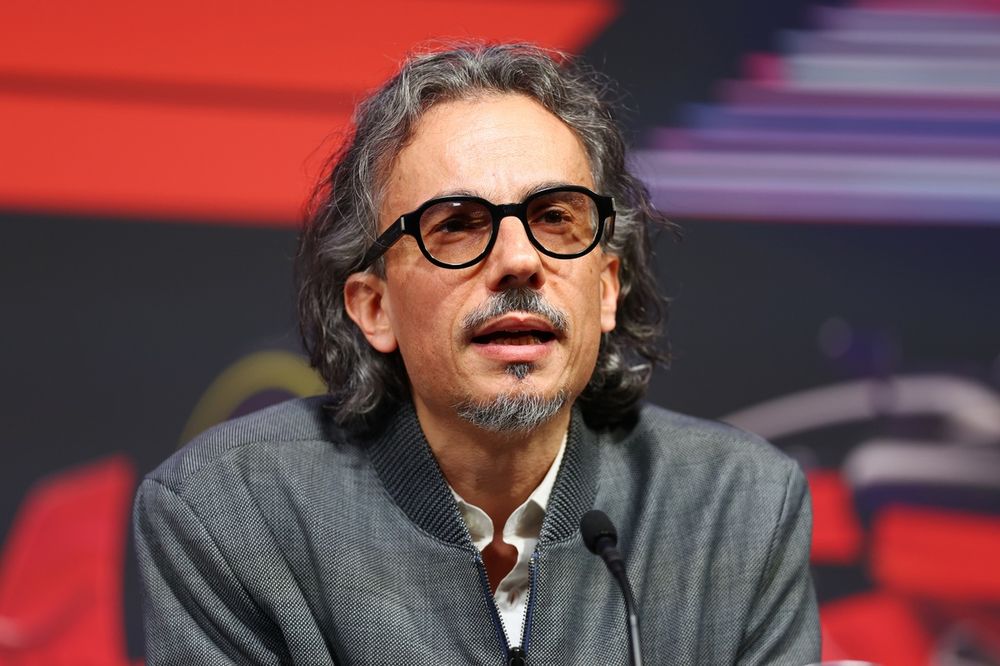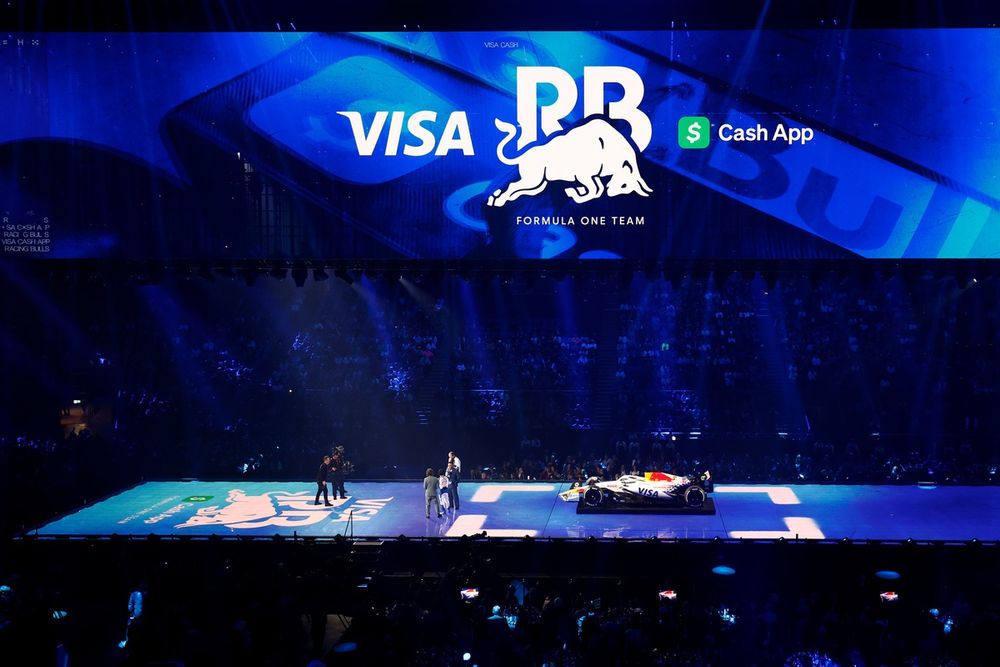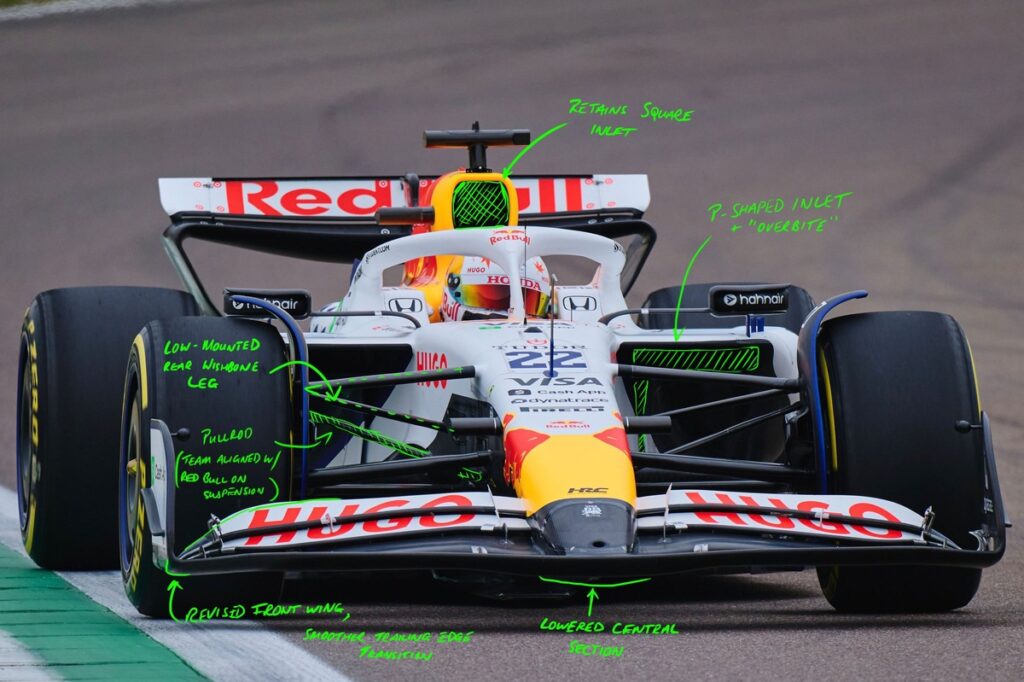Racing Bulls has, quite rightly, garnered plaudits for its switch to a white livery for 2025, producing a new(ish) twist to the formula of Red Bull influenced liveries as its ‘sister’ team completes a decade with the same design. White cars haven’t always been popular, particularly in the mid-2000s when it felt like every manufacturer team had one, but the VCARB 02’s matte tones just feel right.
We’ve now seen the team’s second car since its rebrand from AlphaTauri hit the road and, although it definitely ticks all the boxes usually indicative of “evolutionary design”, there are a few key changes and upgrades that set it apart from its predecessor.
The suspension at the front appears to have largely the same geometry, retaining the pull-rod formula and low-mounted rear leg of the upper wishbone, which also hints towards Red Bull’s direction for 2025 as the two teams share suspension layouts. Racing Bulls had also hidden the outer mounting point of its pull-rod behind the brake ducts last year, but a new duct assembly appears to clear a path around the pull-rod instead.
In line with what has become fashionable, Racing Bulls has also adopted the overbite sidepod inlets to follow the other teams that gravitated towards the design popularised by Red Bull and McLaren. The inlet shape became clear by enhancing the brightness of the image, which has been marked on our annotated images of the car, and visibly follows the P-shape by opening up a vertical inlet along the chassis flanks.
Visually, the VCARB 02 does not look completely distinct from the car that preceded it around the engine cover, as it retains the high-shouldered outlets that help to grow the channels along the top of the sidepods – which appear to have become broader as the team has put greater attention on keeping the flow controlled energised in this part of the car.
The square rollhoop inlet remains, as does the general rear wing geometry and the push-rod rear suspension; the team is keeping a platform that it knows and feels it can refine before the attention switches to 2026. There are also a number of subtle changes to the front wing, which we thought we’d explore in a little more detail.
RB opted for an angular, pointy nose last season, and a front wing with a slightly raised section where it met the nose to drive more airflow underneath the car. Now known as Racing Bulls, the new nose droops down a little more to, this time, lower the central wing section and perhaps use the wing to trim any stagnating flow here. As such, the nose’s top surface has been smoothed out and the wing elements joined to it reorganised with a longer-chord second element. The top two elements in turn have had their chord lengths reduced.
Details of the new Racing Bulls front nose and wing
Photo by: Red Bull Content Pool
There are all-new endplates, with a switch to a curved leading edge, S-shaped diveplane, and revised junction points to the front wing elements to redefine the direction that the airflow takes around the rest of the car. Although the front wing provides downforce, it must also set up the air optimally for the rest of the car to benefit from.
The trailing edge is also smoothed out over the wing’s span, with the flap adjuster mechanism moved slightly further in-board to open up space for the increasingly complex rear element junction points. Many teams have experimented with using minimally sized attachment points to add curls and exposed tips to strengthen the airflow shed from this area, and Racing Bulls’ latest car largely picks up from where its predecessor left off in this area.
Overall, the differences between the VCARB 01 and 02 are not glaring, but there is clear evolution here. And this all comes against the backdrop of the team’s infrastructural changes that have brought it geographically closer to Red Bull’s lead operations in Milton Keynes, as its UK operations have left the Bicester facilities it once occupied – these, the team had previously explained, had become far too small for the growth of the Racing Bulls operation.
With renewed efforts from its midfield rivals, Racing Bulls will have a tough job on its hands to achieve last year’s ambition of finishing sixth overall in the constructors’ championship
This also furthers the technological links with Red Bull too; once the engine operation is up and running for 2026, Racing Bulls will be right next to it – and will also be very close to the new wind tunnel once that comes online next year. This adds to the technology-sharing deal the two teams have within the bounds of the rules, which primarily involves the gearbox and suspension packages.
Team principal Laurent Mekies explained what the team was looking to get out of the new VCARB 02, underlining the key areas that he thought were up for improvement in last year’s car. He also conceded that the first part of the 2025 season might be tough, suggesting that the team was going to invest heavily in improvements in the early phase of the year to make the most of its new facilities.
“In terms of what we were looking for I think there is two streams – in terms of car characteristics, we wanted to have a car that performs a bit more consistently compared to last year,” he said. “We had very good moments last year. We had more difficult races, so in terms of overall target, we have tried to understand what made our car not so consistent last year.

Mekies has overseen Racing Bulls’ move into a new Milton Keynes base and develop its 2025 challenger this winter
Photo by: Getty Images
“Hopefully, we will be able to address some of that and we have done that in parallel with evolving the team, to continue to build the team. I’m not here to tell you that we think we have solved all of our competitiveness issues, but certainly the team is gelling together in the right directions. We moved into our Milton Keynes facility on 2 January, so we have now two very good headquarters.
“Is it really yet to say the car is up there? No, we don’t think it is yet, and we expect a tough first part of the season – but with the conviction that the direction of travel is the right one.”
In any case, the car is at least pretty – but with renewed efforts from its midfield rivals, Racing Bulls will have a tough job on its hands to achieve last year’s ambition of finishing sixth overall in the constructors’ championship. What it has, however, is a new base to build on, and one that the team’s key personnel believe will help to raise its level over the coming years.
Subscribe to Autosport Plus for more Formula 1 technical and in-depth analysis ahead of the 2025 season.

What can Racing Bulls produce in 2025?
Photo by: Red Bull Content Pool
In this article
Jake Boxall-Legge
Formula 1
RB
Be the first to know and subscribe for real-time news email updates on these topics
Subscribe to news alerts
Read the full article here

